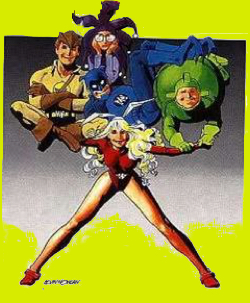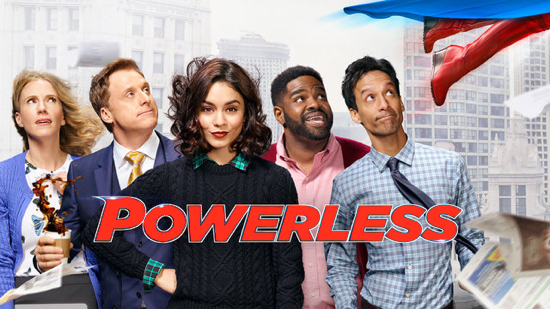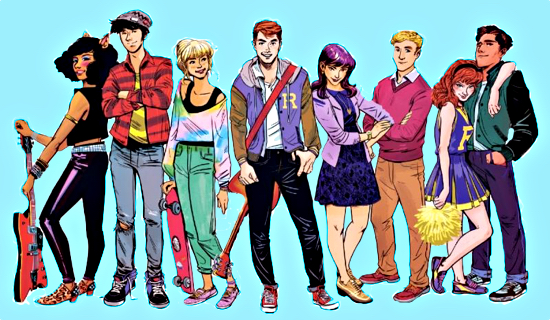Joe Corallo: Powerless And Super
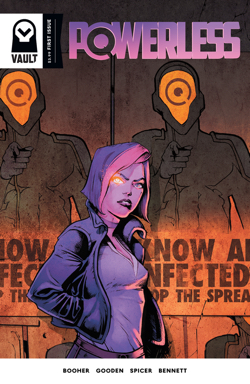 Back in February, a new comics publisher debuted called Vault Comics They hit the ground running with Fissure by Tim Daniel and Patricio Delpeche. Focusing on telling fresh, fast paced science fiction and fantasy stories, Vault has managed the Herculean feat of launching six different comic book series within three months and I’ve picked up all of them.
Back in February, a new comics publisher debuted called Vault Comics They hit the ground running with Fissure by Tim Daniel and Patricio Delpeche. Focusing on telling fresh, fast paced science fiction and fantasy stories, Vault has managed the Herculean feat of launching six different comic book series within three months and I’ve picked up all of them.
One of those series, Powerless, gives us a fresh take on the idea of superheroes; something you’ll rarely hear me say. I got the chance to talk with Powerless creator/writer David M. Booher and artist Nathan C. Gooden.
Joe Corallo: Let’s start with the basics. For those who aren’t familiar, what’s each of your elevator pitches for Powerless?
David Booher: Tough question because I could go on for days about this story. Here’s the 37-second pitch: We’ve flipped the idea of superpowers on its head. Every single person on the planet has some extraordinary ability, but a virus is spreading that takes away the powers of those infected. Using elite agents, the government has instituted Quarantine and the infected are starting to fight back violently. Our main characters find themselves caught right in the middle.
Nathan Gooden: Powerless is a world that asks the question: Do superpowers really solve any of the world’s issues? Does the ability to switch places with anyone or help the life of a depressed teenager, only add fuel to the flames of a brewing war? It’s a character-driven thrill ride that will answer these questions and many more.
JC: What was the genesis of this project? When did you each get involved?
DB: I created the series, but I’ve actually been nurturing the concept for years now. It sprang from my love of stories about people with extraordinary powers, from traditional superheroes to novels like Firestarter and Carrie by Stephen King. With so much out there, I took it as a challenge to create something fresh and different. It came to me – what if there were no superheroes because everyone had powers? What if I didn’t? From there it snowballed: How would I survive in that world? Where would I find power? How would others look at me? And on and on.
NG: I met David four years ago at the San Diego Comic-Con and we immediately hit it off. His pitch completely sold us on the idea of Powerless. We knew we were going to publish it, but I was even more honored and humbled, to have David ask me to do the art for the series.
JC: Powerless takes place in a world with a wide range of existing superhuman powers. What kind of powers can people expect to see explored and why did you pick the powers that you did?
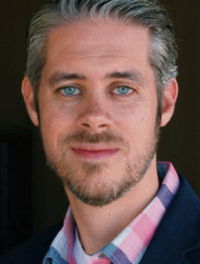 DB: Again, it was about doing something that felt new. So, yeah, readers will see powers they’ve probably seen before – controlling elements, super speed, and telekinesis. But how about a million telekinetics? Or five million pyrokinetics? In a world where a superpower is no longer extraordinary, no one’s impressed that you can start fires. Now, how good you are with that power? That’s a different story. To use a sports analogy: I can throw a baseball over home plate, but will I ever be a pro pitcher? Hell, no. Pros have spent years training. The same with powers – lots of people might be able to do a certain thing, but you better believe there are pros who have perfected it.
DB: Again, it was about doing something that felt new. So, yeah, readers will see powers they’ve probably seen before – controlling elements, super speed, and telekinesis. But how about a million telekinetics? Or five million pyrokinetics? In a world where a superpower is no longer extraordinary, no one’s impressed that you can start fires. Now, how good you are with that power? That’s a different story. To use a sports analogy: I can throw a baseball over home plate, but will I ever be a pro pitcher? Hell, no. Pros have spent years training. The same with powers – lots of people might be able to do a certain thing, but you better believe there are pros who have perfected it.
Then there are the rarer powers. Switch is a modified teleporter who can swap places within anyone in her line of sight. Billy is a chronokinetic with the ability to go back in time 37 seconds. We carefully selected these powers because they have consequences for these characters as the story goes on. Our whole team has spent hours and hours talking about this world to figure out how it would really work. It’s been a ton of fun!
NG: I have always believed in taking the reader somewhere they have never been. So pushing the boundaries of super powers was such a treat. Without giving too much away, I’d like to call attention to one of my favorite characters, Grant Porter. He’s a mid level Serokinetic who can extract blood from organisms in a unique way. It will make for some beautiful, but gruesome brutality.
JC: Why Vault Comics?
DB: Long before Vault existed, I met Adrian Wassel (editor) and Damian Wassel (publisher) along with Nathan at conventions when they were publishing gorgeous graphic novels under a different imprint. I loved their books so much I pitched Powerless to them. The timing couldn’t have been better because they were already talking about creating Vault Comics. Then Nathan came on board as the artist and we were off to the races. They’ve been nothing but amazing from the very beginning.
NG: Well I have been a part of Vault Comics since day one, literally. Adrian and Damian are my very close cousins (more like brothers), so it was a no brainer to be part of the team and help the family.
JC: A common critique of mainstream comics lately is that there isn’t enough story in individual issues. That’s certainly not the case here with Powerless which is dense in story as well as panels and dialogue. What drove the decision to pack so much into the first issue of Powerless and what were the benefits and challenges of that?
DB: I’ll let Nathan talk about page layouts, since I almost always defer to him on that. For my part, I didn’t really make a conscious decision about how much or how little to put in the first issue. It was all dictated by the story. We had 28 pages to create a complex, nuanced world on the brink of transformation and characters who react to it in very different ways. And then we had to overlay all of that with superhuman abilities. There was a lot of ground to cover, and hopefully issue one balances all of that to hook readers. As the series moves forward, we do open up the pages and dialogue a bit now that the world has been established.
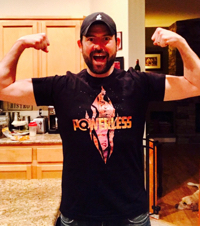 NG: I wanted to get the readers into the world as fast as possible so we could prove to them that we are going off the beaten path. You won’t have to invest months only to get a small taste. I went with an almost kaleidoscope panel design to fill this issue with as much depth and detail as humanly possible, sometimes leaving Deron with the hardest job of all. As David stated, the issues do intentionally open up as they progress and the panels and compositions will reflect that.
NG: I wanted to get the readers into the world as fast as possible so we could prove to them that we are going off the beaten path. You won’t have to invest months only to get a small taste. I went with an almost kaleidoscope panel design to fill this issue with as much depth and detail as humanly possible, sometimes leaving Deron with the hardest job of all. As David stated, the issues do intentionally open up as they progress and the panels and compositions will reflect that.
JC: To follow up on that, could you all discuss how you went about laying out the more complex pages and what was the most complex page to put together from the first issue?
DB: One thing I love about Nathan’s art (among so many things!) is his use of nontraditional page layouts. This is a non-traditional story, so it fits perfectly. We didn’t make Deron’s lettering job easy at all, but he sure made it look that way. Beyond those things, I’ll let Nathan and tell you which pages in the first issue drove him nuts!
NG: Pages 13 and 14 gave me a very big challenge. This is the first major conflict and has several Quarantine agents using their powers at the same time. It was a struggle to not make it just a big glowing mess or fists and kicks. As far as layout, I really wanted to walk the line of overwhelming the reader, without kicking them out of the book.
JC: While reading Powerless #1 I interpreted influence from events in American history such as the internment of Japanese Americans in World War II, the AIDS epidemic, and politics post 9-11. How did these aspects of history impact the story of Powerless and what other historical and political events played a role in creating this story?
DB: As I wrote the scripts, of course lots of these historical events were in the back of my mind. As a gay creator, I probably thought most about the AIDS crisis and the horrible treatment of LGBT people that still happens today. Honestly, it’s been hard to stay ahead of all the crazy social and political events happening right now. I mean, if I wrote some of our current events into a script, I’d get laughed out of my editor’s office. That said, the political and social aspects of Powerless are there, but they provide the backdrop for the very personal stories of these characters and how they react to each other and the world around them.
NG: I think David covered that very well. I would just add, those exact thoughts are what drew me to the series in the first place.
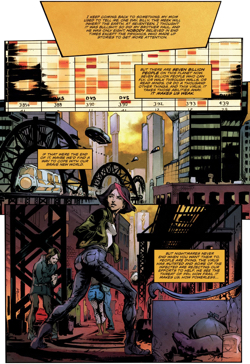 JC: What fictional stories, comics or otherwise, influenced Powerless as well your other works?
JC: What fictional stories, comics or otherwise, influenced Powerless as well your other works?
DB: I think everything I read or see influences me in some way. I was an 80’s kid and I still love just about everything from that decade. Lately I’ve been focused on reading a lot of what Image, IDW, Black Mask, and of course Vault have been publishing. It’s incredible to watch indie creators push the boundaries of comics and see indie publishers support that. I will give a shout-out to IDW’s Locke & Key by Joe Hill. A masterpiece of comic storytelling.
NG: I’d have to say, just my love for all things X-Men as a child. I’d have to give a huge shout out to Saga‘s creators, Brian K Vaughan and Fiona Staples for really reigniting my creative fire.
JC: There are quite a few different factions in this comic leading to a wide range of outfits and uniforms. Can you discuss the process behind developing these outfits and uniforms? Any nods to uniforms from stories you love?
DB: I’ll let Nathan field this one. Like page layouts, I left most of the character design in his capable hands. Seeing the amazing results, I’m glad I did!
NG: Oh, I could go on for days about the design of these characters but I will try and focus in on the most important among them, Quarantine. I wanted this to feel like an oppressive version of Apple’s marketing. Very recognizable logo that will be spread across the globe by force. The uniforms themselves, I wanted a modern Nazi feel. Crisp clean uniforms, where individuality is reserved for those of high rank. The boots and capes for decoration of higher ranking officials. I also had to think of how clothing would change in a world where people could burst themselves into flames or change their body mass in the matter of seconds.
JC: Diversity has been a hot topic in comics lately. Judging by the diverse group of characters featured in Powerless, diversity is important to you all. How did you go about creating a diverse cast of characters and why is diversity in comics important to you?
DB: For me, there was no question but to include a diverse cast. Powerless exists in a world very much like ours, and diversity is part of that. I also wanted to create characters that are relatable for all readers. But it’s not just about diversity for diversity’s sake. If I included characters with all the same background and experiences, they’d just agree on everything. How boring would that be? When characters start from different places, that’s when things get interesting.
NG: Powerless is an exploration into civil rights. It’s only natural to try and see it from as many sides as possible. Visually, I wanted every reader to have the chance to see themselves in at least one of the main characters. Diversity has always played a critical role in my life. I’m biracial, and often wondered as a child, why the heroes or characters didn’t look like me. Sure, there were blonde hair and blue eyed characters that look like my mother’s side of the family. Darker skinned characters that resembled that of my father’s side, but where was the character that looked like me?
Sorry for rambling, but diversity was important to me when doing all of the designs for the world.
JC: It’s fine, I don’t mind rambling! It was great hearing what you both have to say about diversity. Before we wrap this up, could you tell us where people can get a copy of Powerless #1 and when Powerless #2 will be available?
DB: Issue #1 is on shelves now at comic shops. Issue #2 will be on shelves tomorrow!
NG: Issue #1 is available everywhere Diamond distributes, just ask your local comic shop. Issue #2 is out Wednesday April 26th. Also, A huge shout out to Oliver Ridge and Blood Moon, who helped make this all possible.
JC: Thank you both so much for taking the time to chat with me, and for everyone reading this interview, go check out Powerless from these guys and letterer Deron Bennett as well as the rest of Vault Comics’ line-up!


